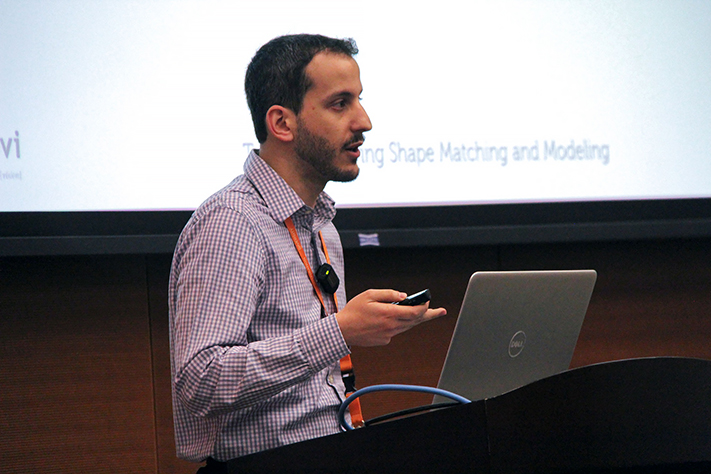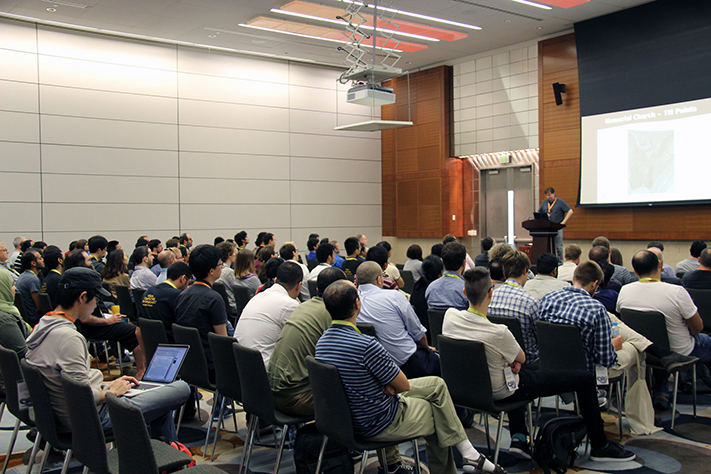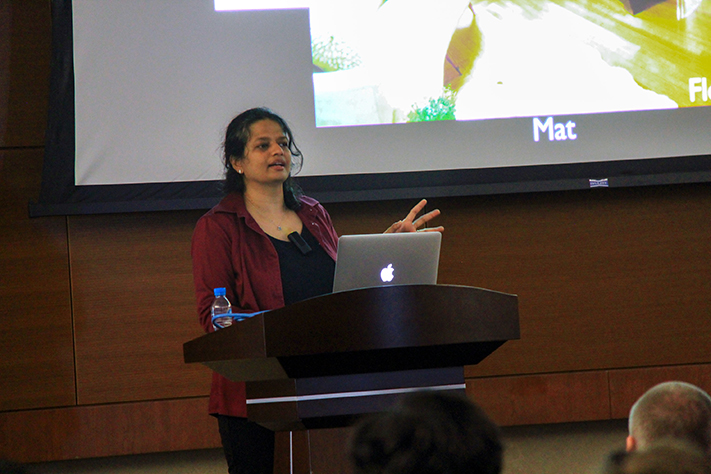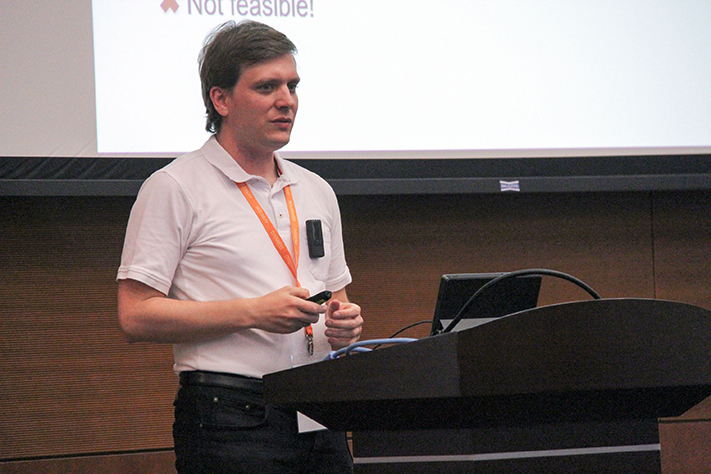Visualizing the future of computing

Computer scientist and Saudi native Ibrahim Alhashim from Simon Fraser University speaks about networking topology and specifically shape matching and modeling at the KAUST Visual Computing (KAUST RC-VC) – Modeling and Reconstruction conference.
At KAUST, the Visual Computing Center (VCC) draws its expertise from a pool of disciplines, including computer science, electrical engineering, mechanical engineering and applied mathematics. The center utilizes a range of application domains to tackle problems of unique importance to the Kingdom and create commercial opportunities in the form of startup companies as well as patents and licensing agreements.
The VCC shared its interdisciplinary approach to device development, image and video understanding, semantic analysis, geometric modeling, simulation and visualization with global partners and colleagues at the recent on campus Visual Computing (KAUST RC-VC) – Modeling and Reconstruction conference.
The conference, which was held from April 10 to 12, brought visual computing experts together from both KAUST and abroad and industry representatives with the intention of focusing on computer graphics—specifically on topics centered on geometry and simulation.
A global and local outlook
In his opening remarks, Wolfgang Heidrich, director of the VCC, described his center’s research thrust and how its vision fits with the University’s overall mission and values; he also welcomed the overseas conference attendees to the University.“KAUST is striving to be a destination for researchers and research—people come here because of what is going on in science and education. KAUST is a globally oriented research university, but we are also trying to kick-start the local industry. From the center's point of view, we also look at startups, of which FalconViz is one of the most successful and most mature,” he said.
“KAUST is a very different place to come to conferences and we are very excited to see the work you are all going to present,” Heidrich added.

Matthieu Desbrun, professor of computing and mathematical sciences, Caltech gave the first keynote presentation at the KAUST Visual Computing (KAUST RC-VC) – Modeling and Reconstruction conference.
‘Equilibrium is a geometric statement’
The first keynote presentation of the conference was by Matthieu Desbrun, professor of computing and mathematical sciences, Caltech. Desbrun’s presentation was on the power of primal/dual meshes for modeling and animation, in which he discussed the notion of orthogonal dual diagrams by displaying a series of recent works that explored the full space of orthogonal primal/dual meshes.Desbrun also covered a range of real-world applications varying from point sampling and fluid dynamics to barycentric coordinates and self-supporting masonry.
“Voronoi diagrams have been the basis for lots of computer programs and meshes in the past,” he noted. “Equilibrium is a geometric statement—it is a well-studied problem, yet no full characterization of solutions is available. Simple geometry principles can have so many applications."
A continuous interpolation
Paul Kry, associate professor at McGill University, presented his work exploring the trade-off between high-fidelity motion and interactive simulation rates for physically based simulation of contact, deformation and articulated structures. Kry also covered examples such as numerical coarsening of elastic solids, discretization of contact at arbitrary resolutions and reduced models for compliant structures.“Contact-deformation articulated structures are important for training, games, movies and simulation. However, there are also some important limitations with embedded meshes. We can use the arbitrary resolution to deal with the contact problem,” Kry said.
Another invited international attendee, a computer scientist and Saudi native Ibrahim Alhashim from Simon Fraser University, spoke about networking topology and specifically shape matching and modeling. Alhashim, a recipient of the 2015 Alain Fournier Ph.D. Dissertation Award, said, “3-D modeling is hard—you need to recombine or shuffle the different parts from shapes.”
“In our work, adding continuous blending produces richer varieties. Novel and inspiring designs come up from having blended shapes. We need to find a continuous interpolation of two man-made 3-D shapes,” Alhashim added.
In the final presentation of the day, Justin Solomon, assistant professor in MIT's Department of Electrical Engineering and Computer Science and one of Forbes Magazine’s 30 Under 30: Science, spoke about the geometric problems that occur in computer graphics, vision and machine learning. In his opening remarks, Solomon said, “Geometry in the application implies geometry in the computational problem. Information that spreads out a little faster still doesn't fix this problem.”
He went on to describe new methods for problems arising in shape analysis/correspondence, flows on graphs and surface parameterization.

Kavita Bala, professor in computer science at Cornell University and editor-in-chief of Transactions on Graphics (TOG), speaks to conference attendees at the KAUST Visual Computing (KAUST RC-VC) – Modeling and Reconstruction conference. Photo by Meres J. Weche.
A world full of complex materials
Day two of KAUST RC-VC opened with a keynote lecture by Kavita Bala, professor in computer science, Cornell University and editor-in-chief of Transactions on Graphics (TOG). Bala’s Lightcuts research is the core production rendering engine in Autodesk's cloud renderer; her research on instance recognition is the core technology of GrokStyle's visual search engine, and her work on 3-D mandalas was featured at the Rubin Museum of Art in New York.“We are drowning in images. Everyone has a cell phone and is attempting to capture the world. Wouldn't it be great to capture these real-world images and use them to better understand the world around us? I love problems that I don't understand—that's what research is all about,” she said.
In her keynote entitled “Materials in the Wild,” she spoke about how in our daily lives we are brought into contact with a wealth of materials that contribute to both the utility and aesthetics of our environment. Bala also described the differences between human and machine perception of materials and their appearance.
“When I talk about the 'wild' I'm not talking about the jungle—I'm talking about studies outside of the laboratory in a real-world environment. One of the objectives when we do this kind of modelling is to make the virtual representation of an item(s) indistinguishable from the real item(s)," Bala said.
"A lot of effort has gone into computer technology and material recognition. We trained our program to realize the object coming in and classify it accordingly. Through deep feature interpolation, we can produce a realistic interpretation of an image in three minutes," she continued. "Humans are good at disambiguating; we can recognize an object, but can the computer system recognize it?”

Roland Ruiters, a senior researcher with Autodesk, discusses data-driven interpolation of optical properties at the KAUST Visual Computing (KAUST RC-VC) – Modeling and Reconstruction conference. Photo by Meres J. Weche.
‘Some materials remain challenging'
During the afternoon sessions, Roland Ruiters, a senior researcher with Autodesk, discussed the data-driven interpolation of optical properties. His talk was based on his work during his postdoctoral studies at the Institute of Computer Science II at the University of Bonn.“One of the challenges of the data-driven approach is that you have to take a lot of measurements. Editing can also be difficult due to the high complexity of the data sets —measurements are also costly. We would like to create novel materials that can be used at a different date,” Ruiters said.
“We interpolate neighborhoods instead of whole images. Through our work, we create interpolated materials. Data-driven material representations can be used to get high-quality renderings for a wide range of materials. However, some materials remain challenging—there are large data sizes and long computation times and we need more intuitive user interfaces,” he concluded.
A high-caliber conference
The third and final day of the conference was a mix of presentations, industrial symposiums and an open house at the VCC. The open house, which was sponsored by the KAUST Industry Collaboration Program (KICP), featured demonstrations and exhibitions from the VCC, the KAUST Visualization Lab and local industry partners."We were really excited to host this research conference. Our students, faculty and staff benefited from many fruitful discussions with the invited participants from academia and industry. We are particularly happy about the high caliber of external researchers who attended the conference, and we believe the conference will be a starting point for productive collaborations in the future," said Peter Wonka, associate director of the VCC.
- By David Murphy, KAUST News

